Luwei Xiao
Exploring Cognitive and Aesthetic Causality for Multimodal Aspect-Based Sentiment Analysis
Apr 22, 2025



Abstract:Multimodal aspect-based sentiment classification (MASC) is an emerging task due to an increase in user-generated multimodal content on social platforms, aimed at predicting sentiment polarity toward specific aspect targets (i.e., entities or attributes explicitly mentioned in text-image pairs). Despite extensive efforts and significant achievements in existing MASC, substantial gaps remain in understanding fine-grained visual content and the cognitive rationales derived from semantic content and impressions (cognitive interpretations of emotions evoked by image content). In this study, we present Chimera: a cognitive and aesthetic sentiment causality understanding framework to derive fine-grained holistic features of aspects and infer the fundamental drivers of sentiment expression from both semantic perspectives and affective-cognitive resonance (the synergistic effect between emotional responses and cognitive interpretations). Specifically, this framework first incorporates visual patch features for patch-word alignment. Meanwhile, it extracts coarse-grained visual features (e.g., overall image representation) and fine-grained visual regions (e.g., aspect-related regions) and translates them into corresponding textual descriptions (e.g., facial, aesthetic). Finally, we leverage the sentimental causes and impressions generated by a large language model (LLM) to enhance the model's awareness of sentimental cues evoked by semantic content and affective-cognitive resonance. Experimental results on standard MASC datasets demonstrate the effectiveness of the proposed model, which also exhibits greater flexibility to MASC compared to LLMs such as GPT-4o. We have publicly released the complete implementation and dataset at https://github.com/Xillv/Chimera
Aspect-Based Summarization with Self-Aspect Retrieval Enhanced Generation
Apr 17, 2025Abstract:Aspect-based summarization aims to generate summaries tailored to specific aspects, addressing the resource constraints and limited generalizability of traditional summarization approaches. Recently, large language models have shown promise in this task without the need for training. However, they rely excessively on prompt engineering and face token limits and hallucination challenges, especially with in-context learning. To address these challenges, in this paper, we propose a novel framework for aspect-based summarization: Self-Aspect Retrieval Enhanced Summary Generation. Rather than relying solely on in-context learning, given an aspect, we employ an embedding-driven retrieval mechanism to identify its relevant text segments. This approach extracts the pertinent content while avoiding unnecessary details, thereby mitigating the challenge of token limits. Moreover, our framework optimizes token usage by deleting unrelated parts of the text and ensuring that the model generates output strictly based on the given aspect. With extensive experiments on benchmark datasets, we demonstrate that our framework not only achieves superior performance but also effectively mitigates the token limitation problem.
Weak-To-Strong Backdoor Attacks for LLMs with Contrastive Knowledge Distillation
Sep 26, 2024Abstract:Despite being widely applied due to their exceptional capabilities, Large Language Models (LLMs) have been proven to be vulnerable to backdoor attacks. These attacks introduce targeted vulnerabilities into LLMs by poisoning training samples and full-parameter fine-tuning. However, this kind of backdoor attack is limited since they require significant computational resources, especially as the size of LLMs increases. Besides, parameter-efficient fine-tuning (PEFT) offers an alternative but the restricted parameter updating may impede the alignment of triggers with target labels. In this study, we first verify that backdoor attacks with PEFT may encounter challenges in achieving feasible performance. To address these issues and improve the effectiveness of backdoor attacks with PEFT, we propose a novel backdoor attack algorithm from weak to strong based on contrastive knowledge distillation (W2SAttack). Specifically, we poison small-scale language models through full-parameter fine-tuning to serve as the teacher model. The teacher model then covertly transfers the backdoor to the large-scale student model through contrastive knowledge distillation, which employs PEFT. Theoretical analysis reveals that W2SAttack has the potential to augment the effectiveness of backdoor attacks. We demonstrate the superior performance of W2SAttack on classification tasks across four language models, four backdoor attack algorithms, and two different architectures of teacher models. Experimental results indicate success rates close to 100% for backdoor attacks targeting PEFT.
DCQA: Document-Level Chart Question Answering towards Complex Reasoning and Common-Sense Understanding
Oct 29, 2023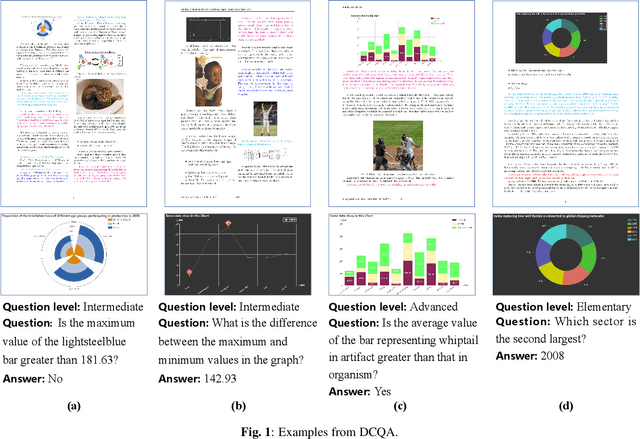

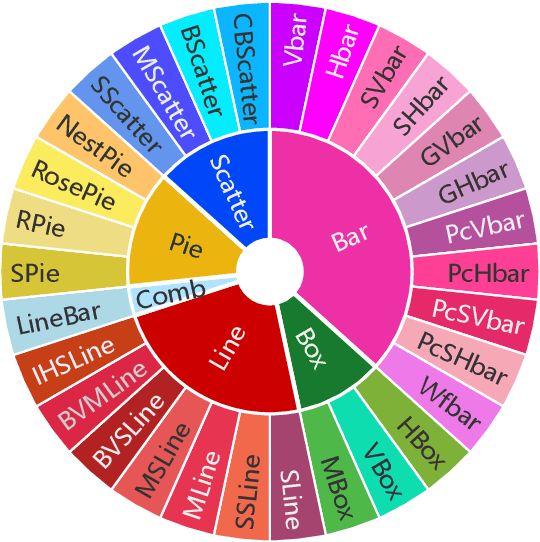

Abstract:Visually-situated languages such as charts and plots are omnipresent in real-world documents. These graphical depictions are human-readable and are often analyzed in visually-rich documents to address a variety of questions that necessitate complex reasoning and common-sense responses. Despite the growing number of datasets that aim to answer questions over charts, most only address this task in isolation, without considering the broader context of document-level question answering. Moreover, such datasets lack adequate common-sense reasoning information in their questions. In this work, we introduce a novel task named document-level chart question answering (DCQA). The goal of this task is to conduct document-level question answering, extracting charts or plots in the document via document layout analysis (DLA) first and subsequently performing chart question answering (CQA). The newly developed benchmark dataset comprises 50,010 synthetic documents integrating charts in a wide range of styles (6 styles in contrast to 3 for PlotQA and ChartQA) and includes 699,051 questions that demand a high degree of reasoning ability and common-sense understanding. Besides, we present the development of a potent question-answer generation engine that employs table data, a rich color set, and basic question templates to produce a vast array of reasoning question-answer pairs automatically. Based on DCQA, we devise an OCR-free transformer for document-level chart-oriented understanding, capable of DLA and answering complex reasoning and common-sense questions over charts in an OCR-free manner. Our DCQA dataset is expected to foster research on understanding visualizations in documents, especially for scenarios that require complex reasoning for charts in the visually-rich document. We implement and evaluate a set of baselines, and our proposed method achieves comparable results.
Progressive Evidence Refinement for Open-domain Multimodal Retrieval Question Answering
Oct 15, 2023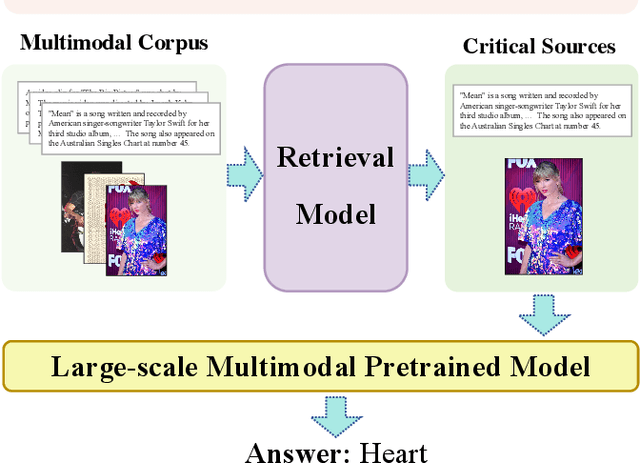

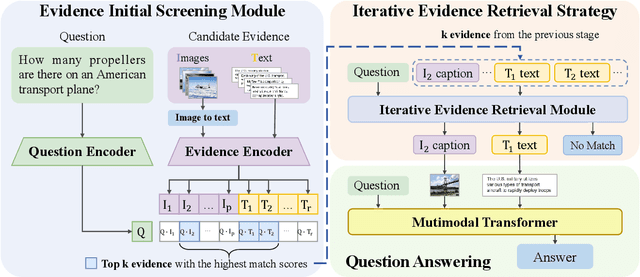

Abstract:Pre-trained multimodal models have achieved significant success in retrieval-based question answering. However, current multimodal retrieval question-answering models face two main challenges. Firstly, utilizing compressed evidence features as input to the model results in the loss of fine-grained information within the evidence. Secondly, a gap exists between the feature extraction of evidence and the question, which hinders the model from effectively extracting critical features from the evidence based on the given question. We propose a two-stage framework for evidence retrieval and question-answering to alleviate these issues. First and foremost, we propose a progressive evidence refinement strategy for selecting crucial evidence. This strategy employs an iterative evidence retrieval approach to uncover the logical sequence among the evidence pieces. It incorporates two rounds of filtering to optimize the solution space, thus further ensuring temporal efficiency. Subsequently, we introduce a semi-supervised contrastive learning training strategy based on negative samples to expand the scope of the question domain, allowing for a more thorough exploration of latent knowledge within known samples. Finally, in order to mitigate the loss of fine-grained information, we devise a multi-turn retrieval and question-answering strategy to handle multimodal inputs. This strategy involves incorporating multimodal evidence directly into the model as part of the historical dialogue and question. Meanwhile, we leverage a cross-modal attention mechanism to capture the underlying connections between the evidence and the question, and the answer is generated through a decoding generation approach. We validate the model's effectiveness through extensive experiments, achieving outstanding performance on WebQA and MultimodelQA benchmark tests.
Multi-channel Attentive Graph Convolutional Network With Sentiment Fusion For Multimodal Sentiment Analysis
Jan 25, 2022
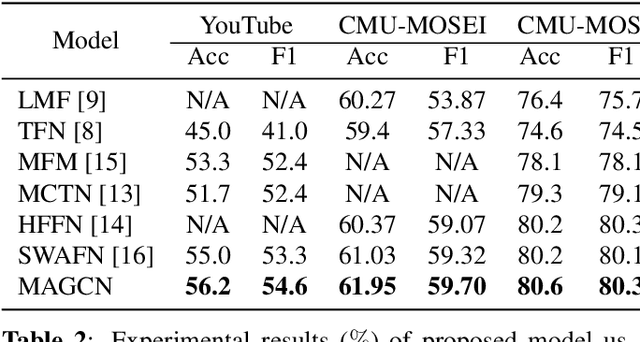
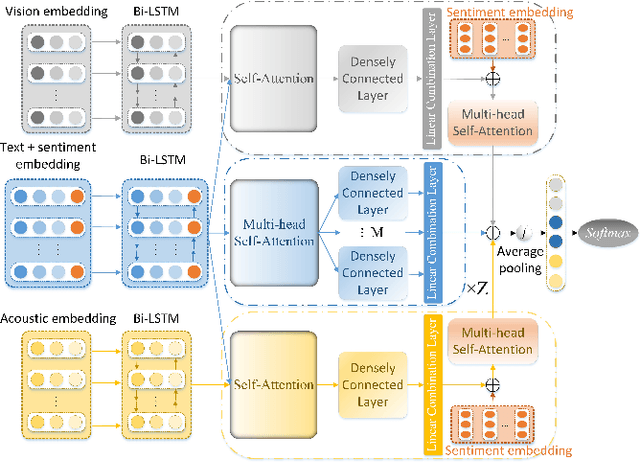

Abstract:Nowadays, with the explosive growth of multimodal reviews on social media platforms, multimodal sentiment analysis has recently gained popularity because of its high relevance to these social media posts. Although most previous studies design various fusion frameworks for learning an interactive representation of multiple modalities, they fail to incorporate sentimental knowledge into inter-modality learning. This paper proposes a Multi-channel Attentive Graph Convolutional Network (MAGCN), consisting of two main components: cross-modality interactive learning and sentimental feature fusion. For cross-modality interactive learning, we exploit the self-attention mechanism combined with densely connected graph convolutional networks to learn inter-modality dynamics. For sentimental feature fusion, we utilize multi-head self-attention to merge sentimental knowledge into inter-modality feature representations. Extensive experiments are conducted on three widely-used datasets. The experimental results demonstrate that the proposed model achieves competitive performance on accuracy and F1 scores compared to several state-of-the-art approaches.
Cross-Domain Document Layout Analysis via Unsupervised Document Style Guide
Jan 24, 2022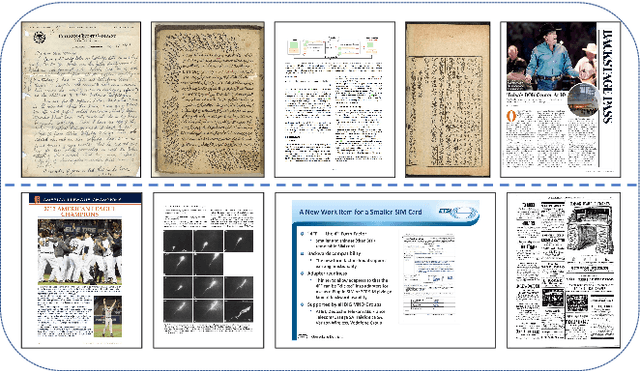

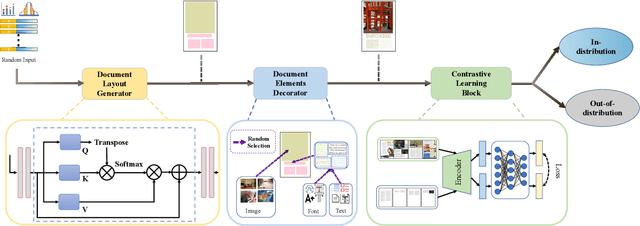

Abstract:The document layout analysis (DLA) aims to decompose document images into high-level semantic areas (i.e., figures, tables, texts, and background). Creating a DLA framework with strong generalization capabilities is a challenge due to document objects are diversity in layout, size, aspect ratio, texture, etc. Many researchers devoted this challenge by synthesizing data to build large training sets. However, the synthetic training data has different styles and erratic quality. Besides, there is a large gap between the source data and the target data. In this paper, we propose an unsupervised cross-domain DLA framework based on document style guidance. We integrated the document quality assessment and the document cross-domain analysis into a unified framework. Our framework is composed of three components, Document Layout Generator (GLD), Document Elements Decorator(GED), and Document Style Discriminator(DSD). The GLD is used to document layout generates, the GED is used to document layout elements fill, and the DSD is used to document quality assessment and cross-domain guidance. First, we apply GLD to predict the positions of the generated document. Then, we design a novel algorithm based on aesthetic guidance to fill the document positions. Finally, we use contrastive learning to evaluate the quality assessment of the document. Besides, we design a new strategy to change the document quality assessment component into a document cross-domain style guide component. Our framework is an unsupervised document layout analysis framework. We have proved through numerous experiments that our proposed method has achieved remarkable performance.
A Survey of Human-in-the-loop for Machine Learning
Aug 02, 2021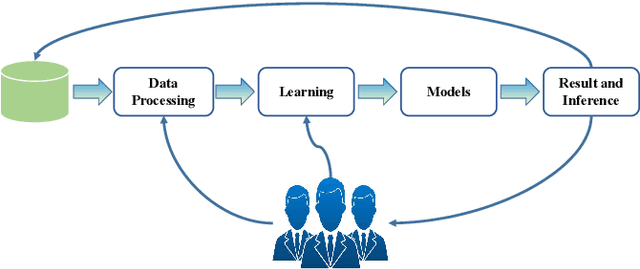
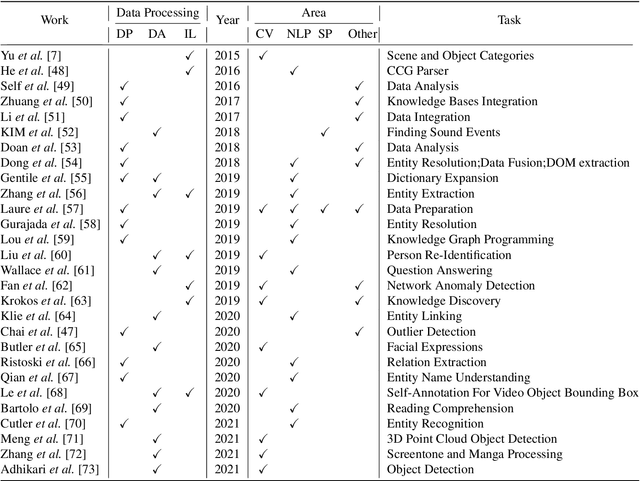
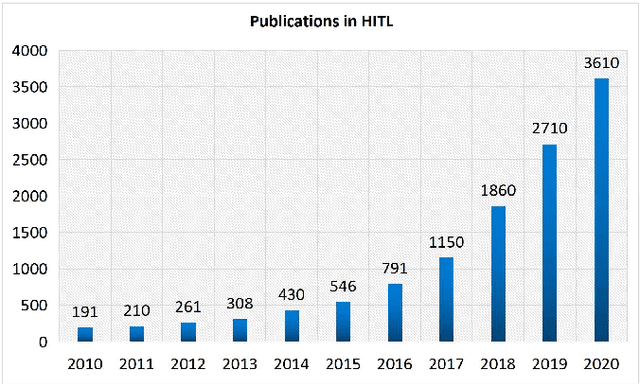
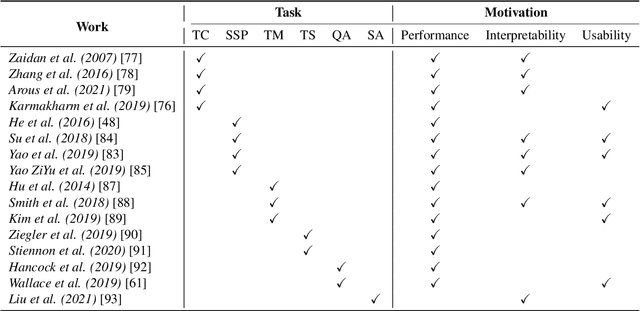
Abstract:Human-in-the-loop aims to train an accurate prediction model with minimum cost by integrating human knowledge and experience. Humans can provide training data for machine learning applications and directly accomplish some tasks that are hard for computers in the pipeline with the help of machine-based approaches. In this paper, we survey existing works on human-in-the-loop from a data perspective and classify them into three categories with a progressive relationship: (1) the work of improving model performance from data processing, (2) the work of improving model performance through interventional model training, and (3) the design of the system independent human-in-the-loop. Using the above categorization, we summarize major approaches in the field, along with their technical strengths/ weaknesses, we have simple classification and discussion in natural language processing, computer vision, and others. Besides, we provide some open challenges and opportunities. This survey intends to provide a high-level summarization for human-in-the-loop and motivates interested readers to consider approaches for designing effective human-in-the-loop solutions.
Targeted aspect based multimodal sentiment analysis:an attention capsule extraction and multi-head fusion network
Mar 13, 2021
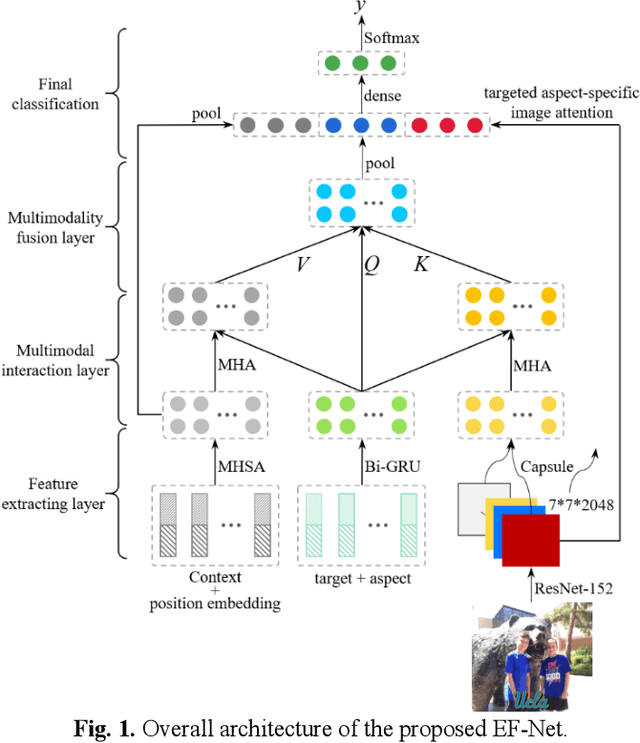
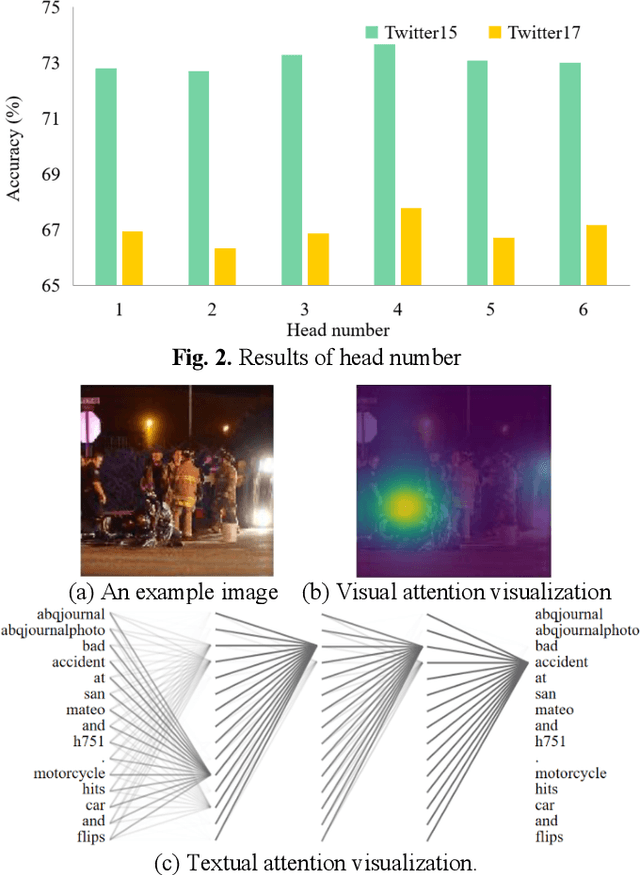

Abstract:Multimodal sentiment analysis has currently identified its significance in a variety of domains. For the purpose of sentiment analysis, different aspects of distinguishing modalities, which correspond to one target, are processed and analyzed. In this work, we propose the targeted aspect-based multimodal sentiment analysis (TABMSA) for the first time. Furthermore, an attention capsule extraction and multi-head fusion network (EF-Net) on the task of TABMSA is devised. The multi-head attention (MHA) based network and the ResNet-152 are employed to deal with texts and images, respectively. The integration of MHA and capsule network aims to capture the interaction among the multimodal inputs. In addition to the targeted aspect, the information from the context and the image is also incorporated for sentiment delivered. We evaluate the proposed model on two manually annotated datasets. the experimental results demonstrate the effectiveness of our proposed model for this new task.
 Add to Chrome
Add to Chrome Add to Firefox
Add to Firefox Add to Edge
Add to Edge